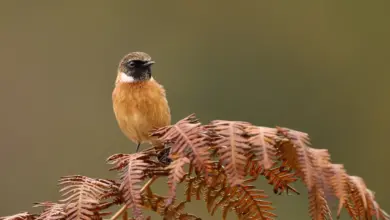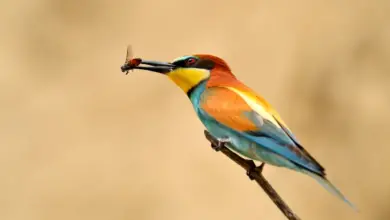The Three-wattled Bellbirds (Procnias tricarunculata) is one of four species of bellbird that live in Central and South America. It is part of the Cotinga family.

Famous for having one of the most unique and distinct vocalizations of any bird in its range, the three-wattled bellbirds exists from Western Honduras south to Eastern Panama. It frequents the middle and upper levels of mountain forests (Cordillera de Tilaran, Caribbean slope of Cordillera Central, both slopes on the Cordillera de Talamanca).
While little is known about the migratory behavior of these birds, they breed primarily in Costa Rican highlands (March-September) and return to lower elevations for the interim months.
Description:
A mature male three-wattled bellbird is chestnut brown and between 25 and 30 cm (10-12 in) long – about the size of a grackle. The body, tail, and wings of the male bellbird are uniformly chestnut-brown, its head white with a black eye ring, eye stripe, and bill. Its name comes from the three worm-like wattles of skin that hang from the base of the bill. These wattles can be as long as 10 cm (4 in) and the middle of the three can be erected into an upright position.
The female bellbirds are smaller and somewhat less striking in appearance. They are golden-brown across the back of the wings and tail with whitish streaking on the face, a buffy-streaked throat, and golden-brown streaking down the chest with pale-grey undertail coverts.
Diet:
They feed on fruit, especially those in the Lauraceae family. Because of this, they are considered an altitudinal migrant as they follow fruiting peaks around the country and even cross borders into neighboring countries on both the North and South ends of Costa Rica.
Song
Because of the secretive behavior of this bird, it is often only detected by its distinctive bell-like call given by the males. At close range, the vocalization is heard as a complex three-part song, the final “bonk” giving the bird its name. This hollow, wooden “bonk” is thought to be among the loudest bird calls on Earth, audible to humans from over half a mile away.
Copyright: Wikipedia. This article is licensed under the GNU Free Documentation License. It uses material from Wikipedia.org.
Please Note: The articles or images on this page are the sole property of the authors or photographers. Please contact them directly with respect to any copyright or licensing questions. Thank you.


